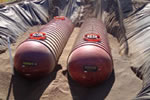 Some UST systems require a cathodic protection (CP) system. Generally, if the steel surface of an underground storage tank (UST) system is in direct contact with an earthen material (soil, gravel, sand, etc), it must be protected from corrosion by a CP system. A permit from the Sacramento County Environmental Management Department (EMD) is required to install, upgrade, repair or replace a CP system in Sacramento County (including all cities in Sacramento County). There are also periodic testing and documentation requirements for the operation of a CP system.
Some UST systems require a cathodic protection (CP) system. Generally, if the steel surface of an underground storage tank (UST) system is in direct contact with an earthen material (soil, gravel, sand, etc), it must be protected from corrosion by a CP system. A permit from the Sacramento County Environmental Management Department (EMD) is required to install, upgrade, repair or replace a CP system in Sacramento County (including all cities in Sacramento County). There are also periodic testing and documentation requirements for the operation of a CP system.
CP Installation, Upgrade, Repair or Replacement Requirements
To install, upgrade, repair or replace a CP system, the UST owner or operator must submit an
Application for Permit to Install, Upgrade or Repair UST(s) and a
Cathodic Protection System Addendum form. A fee and any supporting documents must also be submitted.
Note that the design and installation of CP systems can only be done by persons with special certifications. See the
Cathodic Protection System Addendum form for more details.
The application will be reviewed by EMD staff. If approved, an Authority To Construct letter (aka the permit) will be issued. This letter or permit must be issued before the CP work can begin. The letter will list inspections required during the installation or repair process.
CP Operating Requirements
Once a CP system is operating, there are testing and inspection requirements that must be fulfilled by the UST owner or operator. There are two types of cathodic protection systems: sacrificial anode and impressed current. The periodic requirements vary for these two systems. A brief description of these requirements are listed below:
- Both types of CP systems require testing by a qualified cathodic protection tester within six months of installation and every three years thereafter (23 California Code of Regulations (CCR 2635).
- Impressed current systems must be inspected at least every 60 calendar days to ensure proper working order (23CCR 2635). This inspection can be conducted by anyone familiar with the operation of the CP system (does not have to be a cathodic protection tester). Documentation of these inspections should be kept onsite.
Definitions
Cathodic Protection Tester:
In order to qualify as a Cathodic Protection Tester, one must have a certification that demonstrates an understanding of the principles and measurements of all common types of cathodic protection systems as applied to buried or submerged metal piping and tank systems. There are seven categories of National Association of Corrosion Engineers (NACE) certifications that meet the minimum requirements for Cathodic Protection Tester as stipulated in 23 CCR, Section 2611, Chapter 16. These are:
- Corrosion Specialist
- Cathodic Protection Specialist - Level 3
- Senior Corrosion Technologist
- Corrosion Technologist
- Corrosion Technician (with the stipulation that the technician performs system testing under the direct oversight of one of the above four)
- Cathodic Protection Tester - Level 1
- Cathodic Protection Technician - Level 2
Equivalent training and certification which meet the education and experience requirements for Cathodic Protection Tester may be available other than through NACE. Please contact EMD to determine if other specific training or certification qualifies as a Cathodic Protection Tester.
Sacrificial Anodes:
Sacrificial anodes can be attached to a steel UST system (UST) for corrosion protection. Sacrificial anodes are pieces of metal more electrically active than the steel UST. Because these anodes are more active, the corrosive current will exit from them rather than the UST. Thus, the UST is protected while the attached anode is sacrificed. Depleted anodes must be replaced for continued corrosion protection of the UST (permit required).
Impressed Current:
An impressed current system uses a rectifier to convert alternating current to direct current. This current is sent through an insulated wire to anodes, which are special metal bars buried in the soil near the UST. The current then flows through the soil to the UST system and returns to the rectifier through an insulated wire attached to the UST. The UST system is protected because the current from the rectifier overcomes the corrosion-causing current normally flowing from the tank.
Summary
UST owners and operators who do not comply with all of these requirements may be subject to enforcement action which may include fines and penalties.
If you need more information or have questions, please contact:
Sacramento County Environmental Management Department
Environmental Compliance Division
11080 White Rock Rd., Suite 200
Rancho Cordova, CA 95670
916-875-8550
916-875-8513 (fax)
emdinfo@saccounty.net
